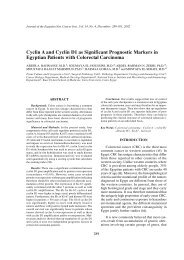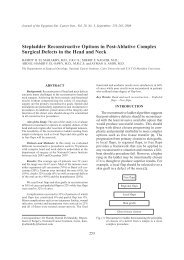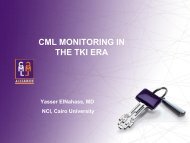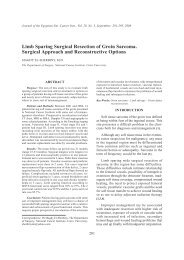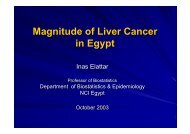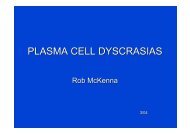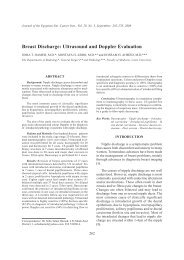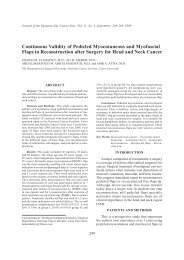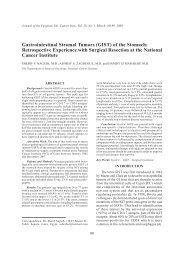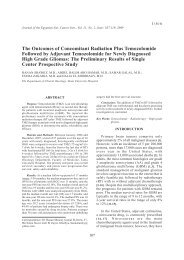Immediate Side Effects of Cranial Stereotactic Radiosurgery and ...
Immediate Side Effects of Cranial Stereotactic Radiosurgery and ...
Immediate Side Effects of Cranial Stereotactic Radiosurgery and ...
You also want an ePaper? Increase the reach of your titles
YUMPU automatically turns print PDFs into web optimized ePapers that Google loves.
328 <strong>Immediate</strong> <strong>Side</strong> <strong>Effects</strong> <strong>of</strong> <strong>Cranial</strong> <strong>Stereotactic</strong> <strong>Radiosurgery</strong>experienced nausea <strong>and</strong> vomiting as immediateside effects <strong>of</strong> cranial streotactic irradiation, ahighly significant positive correlation with thedose delivered to the region harboring areapotrema (Vomiting Center) with cut <strong>of</strong>f point at2 Gy was found. After 2 Gy dose, all patientsTable (1): Post-radiosurgery injury expression (PIE) scoresfor location <strong>of</strong> arteriovenous malformation (Flickingeret al., 1997) [10].developed nausea <strong>and</strong> vomiting (Pearson’s ChiSquare) (p value < 0.0001) [3] as shown in Table(11). Poor correlation data were obtained onanalyzing other encountered immediate sideeffects in relation to any <strong>of</strong> the disease or therapyrelated parameters.Table (4): Karn<strong>of</strong>sky performance scale among 163 patientstreated by stereotactic radiosurgery <strong>and</strong> radiotherapy(NEMROCK 1999-2002).PIE scoreLocationPerformance statusNumber%1 (Low risk)234 (High risk)Frontal lobeCerebellum, temporal lobe, partietal lobeOccipital lobe or basal gangliaMedulla, thalamus, intraventricular, ponsor corpus callosum100-9080-7060-50Total65712716339.843.616.6100Table (2): Radiation therapy oncology group (RTOG)radiosurgery quality assurance guidelines [15].Per protocolMinor(acceptabledeviation)Major(unacceptableConformity≤ 2> 2 & < 2.5> 2.5Dosehomogenity1-2> 0.9 & < 1or> 2 & < 2.5< 0.9 & > 2.5Dosegradient≥ 0.3–Conformity: Prescription Isodose Surface Volume to Target Volume(TV) Ratio.Dose homogenity: Maximum Dose (MD) to Prescription Dose(PD) Ratio.Dose gradient: Target Volume (TV) to Volume Enclosed by 50%(V50%) Ratio.Table (3): Initial diagnosis among 163 patients treated bystereotactic radiosurgery <strong>and</strong> radiotherapy (NEM-ROCK 1999-2002).CatgeoryBenignDiseasesTumorsTotalDiagnosisMeningiomasArteriovenousMalformationsAcuosticNeuromasLow gradeGliomasHigh gradeGliomasPituitaryAdenomasMetastaticBrain diseaseOthers*Number2922*Others include; haemangiopericytoma in 2 patients (1%), chordoma<strong>of</strong> skull base in 4 patients (2%), ependymoma in 4 patients(2%), pineal body tumor in 3 patients (1.5%), glomus jugularein 3 patients (1.5%) <strong>and</strong> medulloblastoma in 3 patients (1.5%).2139208519163–1913132812.553%9.5100Table (5): Lesion volume, multiplicity <strong>and</strong> treatment scheduleamong 163 patients treated by stereotacticradiosurgery <strong>and</strong> radiotherapy (NEMROCK1999-2002).ItemVolume:Range (cc)Median volume (cc)St<strong>and</strong>ard deviationMultiplicity:One lesionTwo lesionsThree lesionsTreatment schedule:SRSSRTValues0.21-65.3112.5±13.6160 patients2 patients1 patient101 (61.9%)62 (38.1%)Table (6): Dose scheme adopted among (101) patientstreated by stereotactic radiosurgery (NEM-ROCK 1999-2002).Volume< 1 cc1-5 cc> 5-125 ccN113357% Dose (Gy)10.932.756.4201510Table (7): Dose contribution to risk structures <strong>and</strong> conformityindex among 163 patients treated by stereotacticradiosurgery <strong>and</strong> radiotherapy (NEMROCK1999-2002).RiskstructureLeft eyeRight eyeBrain stemChiasmaConformityIndexDose range(Gy)0-4.40-3.60-19.40-17.2Range1-2.95Mean dose(Gy)0.470.424.601.30Mean value1.44St<strong>and</strong>arddeviation±0.75±0.59±4.84±4.08St<strong>and</strong>ardDeviation±0.39



